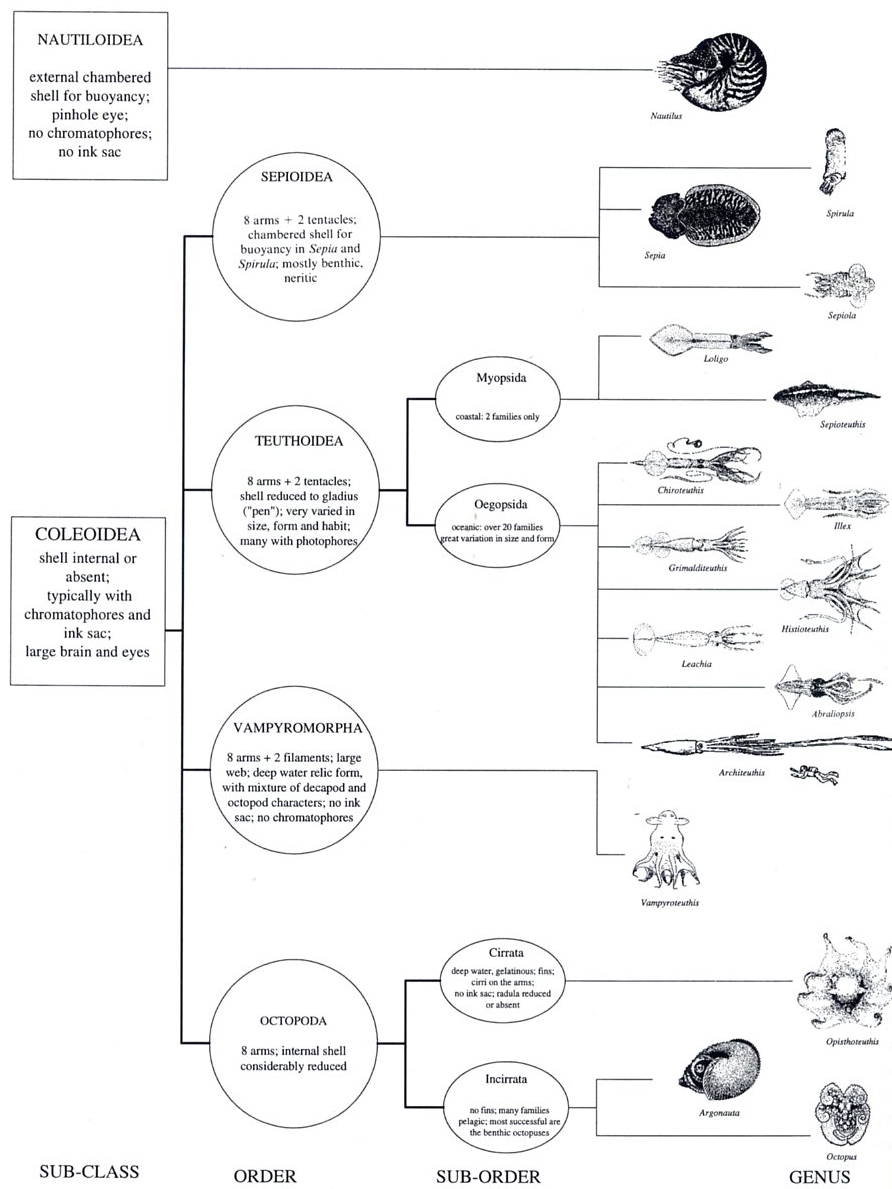Visual Mimicry in Cephalopods
Biology 342 Fall 2007
Aurelia Moran & Matt Lehet
Phylogeny
What is phylogeny?
Phylogenetics is the study of evolutionary relatedness between individuals or groups of organisms. Evolution is regarded as the dividing and branching process, in which populations eventually fulfill one of three outcomes as a result of alterations over time. They may speciate into separate branches, hybridize together, or terminate by extinction. Phylogenetics describes the relationships between organisms at present as well as delving into their evolutionary past.
• The development of mimicry behavior within cephalopods can be explored on an evolutionary scale.
• In order to do so it is useful to establish a definition of the Cephalopods, and look at their history.
• From these observations we can infer selective pressures that underly convergent evolution of mimicry.
Cephalopods are characterized by bilateral symmetry, a protruding head, and a modification of the mollusk foot into a muscular hydrostat which forms arms or tentacles. The class contains two extant subclasses. Coleoidea, in which the mollusk shell has been internalized or is absent; is the subclass which includes octopuses, squid, and cuttlefish. In the Nautiloidea the shell remains. There are over 700 distinct living species of Cephalopods. (Hanlon & Messenger, 1996) Cephalopods are found exclusively in oceans and at all depths.
History
The class of organisms containing both Coleoidea and Nautiloidea developed during the late Cambrian. During the Paleozoic and Mesozoic they were both dominant and diverse marine life forms.(Hanlon & Messenger, 1996) Tommotia, a basal cephalopod, had squid-like tentacles but also a snail-like foot which it used to move across the seabed. Early cephalopods were at the top of the food chain.
The ancient and modern coleoids (group of cephalopods containing soft-bodied creatures) as well as the ammonoids (an extinct taxon), all diverged from external shelled nautiloids during the middle Paleozoic Era, between 450 and 300 million years ago. Unlike most modern cephalopods, ancient coleoids had protective exterior shells. (Hanlon & Messenger, 1996) Internal shells still exist in many non-shelled living cephalopod groups but most truly shelled cephalopods, such as the ammonites, became extinct at the end of the Cretaceous0 ( see image below). Descendents of straight shelled nautiloids, have evolved into modern squid and cuttlefish or become extinct.
.
The major groups of cephalopods showing phylogenetic relationships and diversity. Based on the conventional classification of Voss (1977) (Hanlon& Messenger, 1996)
Note: image is very hard to read. We know. CLICK HERE for larger image.
Crypsis and Mimicry in Cephalopods
The evolution of crypsis in cephalopods probably began when cephalopods lost or internalized their protective outer shell. Shell loss or reduction has occurred in many lineages of cephalopods, occupying diverse ecological niches. There are many possible benefits of shell loss which may have led to the convergent selection of crypsis. Shell reduction reduces the weight of an organism, allows for a more streamline body form, enhances the ability to crawl into small spaces, creates a more distensible body, and exposes the skin to the outside world which is turn permitted the development of fins and colorchanging chromatophores.(Hanlon & Messenger, 1996). It is probably the loss of this protective measures, an external shell, which produced selective pressures for alternative defensive mechanisms. The predominant defensive mechanism that is observed in extant taxa is crypsis through visual mimcry.